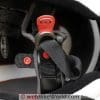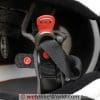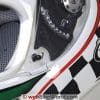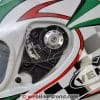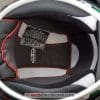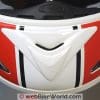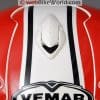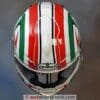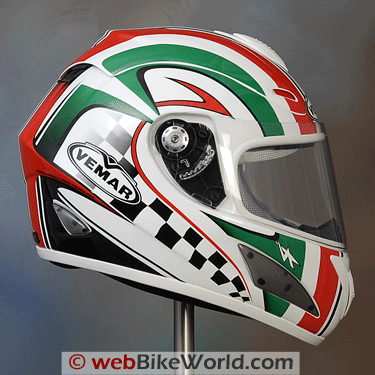It’s good to see Vemar back in the U.S.A.
Meantime, the brand has been popular in other parts of the world for some time.
The VSREV has a different and interesting internal shape.
It may please some owners who may be having a hard time finding a comfortable fit with other brands.
The VSREV has high quality graphics and construction, comfortable lining material and solid construction.
But, the helmet is slightly heavy.
The Vemar VSREV is an update of the original Vemar VSR we reviewed several years ago.
The VSREV is among the helmets that Vemar chose to make their re-entry into the U.S. market after an absence of a few years.
The VSREV is Vemar’s “top of the line” race helmet, and it’s said to be the helmet of choice of MotoGP racers Alex de Angelis and Andrea Dovizioso.
The version shown here has the special “Italy” color configuration and the VSREV is also available in carbon fiber, at a list price of — hold on to your shorts — $1,000.00!
Motonation, the distributor for Vemar (and Sidi and Spidi) in the U.S.A., is also importing the Vemar VTXE, which retails for about $125.00 less than the VSREV and is also a good-looking helmet.
By the way, it’s interesting to note that the Vemar full-face helmets are still being manufactured in Italy.
This may influence some purchasing decisions.
We also reviewed the Vemar Jiano flip-up helmet a couple of months ago, but that helmet did not have a country of origin label, so it’s unclear if Vemar makes the Jiano in Italy or elsewhere.
Paint, Graphics and Overall Quality
The VSREV shown here is the unique “Italy” color pattern. It goes without saying that this is the perfect helmet for Ducati, Moto Guzzi and MV Agusta owners, along with other amici dell’Italia.
The quality of the colors, paint and graphics on this one are outstanding — I’ll bet this is a limited edition, so I’d get one soon if you’re interested.
The only nit I could pick is that I wish the surface had a slightly thicker clear coat to protect the beautiful artwork.
Somehow, I’ve already picked up a scratch on this one, and I think a thicker layer of clear coat on top might have helped prevent this from happening.
Nevertheless, the Italy graphic is very cool — I’ve received many positive comments and I’d swear that people stop and stare as I’m tooling down the street.
I also think the color combination is somewhat of a safety factor, due to its eye-popping visibility.
Another interesting feature of the Italy graphics is the white gasket used on the eye port and around the bottom of the helmet shell.
I haven’t seen this done before, and although I suppose it may pick up some greasy fingerprints here and there, it seems easy to clean and it’s definitely unique.
The VSREV is also available in a red, white and blue color pattern complete with stars, and the star theme is continued in a variety of other very nice color choices.
The quality of the lining and the fittings is also very good, and the lining material is comfortable.
Score: I’ll give the Vemar VSREV an “Outstanding” rating for the overall finish, paint and graphics. I’ll score the quality of the lining and the vent and visor fittings as “Excellent”. See the ratings scale in the summary table at the bottom of this page.
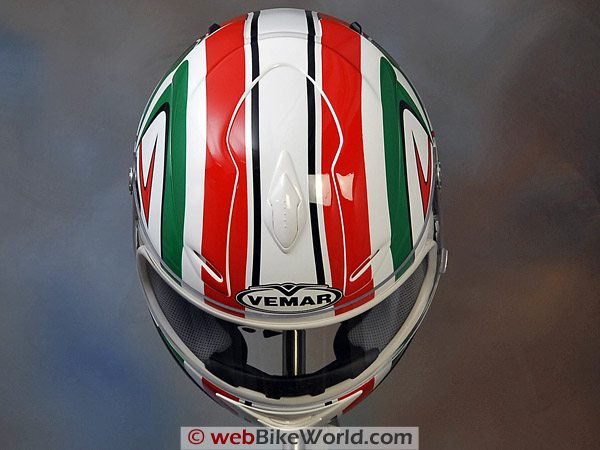
Helmet Shape and Fit
The most interesting and unique feature of the VSREV is its internal shape.
It is different from any other helmet we’ve tried and, in fact, is a completely new type of fit for a motorcycle helmet that creates its own new category which we’re labeling a “round oval”.
Since the VSREV’s fit is so unique, I urge you to take a look at our Motorcycle Helmet FAQ (if you haven’t already) to familiarize yourself with some of the language used to describe motorcycle helmet fit before I get into my discussion of this helmet’s shape.
That page provides information on choosing and fitting a motorcycle helmet (crucial for both comfort and safety!) and for a discussion regarding human head shapes,
Vemar says that the VSREV “features a round shell shape which offers a more generous fit ear to ear and snugger fit front to back” and I think this is a good description.
The VSREV has lots of room on the sides, where if feels slightly bowed on either side of the face.
But it’s narrower up top — almost like a cross between a very round helmet like the Arai Quantum II (review) on the sides and an “intermediate oval” shape like the Arai Vector (review) on top.
This is a different shape than the “standard” helmet fit that we’ve encountered in most helmets.
Manufacturers typically use a “neutral” shape, which could be described as just to the intermediate oval side of round.
If head shapes were plotted to a normal distribution (although it’s uncertain whether head shapes fall into a normal distribution or not), the neutral fit is generally designed to fit the majority of riders.
That’s like one sigma on either side of the mean, or approximately 68% of the population.
More specific shapes like the “intermediate oval” or “long oval” fit correctly on smaller segments of the population, what I call the “two sigma” (about 28%) and “three sigma” (the remaining 4%) crowd.
There are helmets with shapes that are focused on these various populations, with “neutral” shapes like the URBAN N-20 Astro (review) and “round” shaped helmets like the aforementioned Arai Quantum II.
And maybe the Shoei RF-1000 (review) or Shoei TZ-R (review), and there are some “long oval” shapes like the Shark RSi (review) or Arai Profile (review).
That’s pretty much been the universe of motorcycle helmet shapes until now.
But Vemar has staked out a shape all their own, and since they don’t have a name for it, we’re calling it the “round oval”, because it does feel very round on the sides and oval-shaped up top.
We’re not sure who or how many motorcycle owners have this head shape, but obviously Vemar has done some homework and research before they released this design.
Just like a “long oval” shape won’t fit every rider, the Vemar “round oval” shape may not satisfy everyone.
But one thing’s for certain: more options for helmet head shapes are a good thing.
It’s incredibly difficult to actually find a “perfect” helmet fit.
That’s especially true when purchasing sight unseen over the Internet, so more choices mean that motorcyclists have a better chance at finding a comfortable helmet.
My head shape is round, or “earth” shaped as I like to call it, with the widest point at the temples.
This has caused me some measure of grief when trying to find a helmet that fits correctly.
Honestly, out of the 90+ helmets we’ve reviewed so far on webBikeWorld, and others that I’ve tried, there is only one helmet that feels perfect when I pull it over my head, and that’s the Arai Quantum II.
While the quality of the Arai has been disappointing (including continuing problems with the antiquated visor removal system and self-destructing cheek pads), the Quantum II fits me like no other.
Sizing
I also seem to be on the borderline between a size large and extra-large; my head has a 60.5 cm circumference, which usually falls in-between those sizes in most size charts.
But the vast majority of the time, the XL fits best because the slightly smaller size large will usually put too much pressure on my temples.
We first ordered a Vemar VSREV in size XL, but when it arrived it felt huge — like an XXL — which was way too big.
The size large shown here is the replacement, and it fits me more like a slightly large XL, which is still slightly larger than I’d like.
So I’d say that between the unique VSREV fit and the sizing, the helmet is running 1 to 1.5 sizes larger than expected, and plan accordingly.
This may be a helmet that you’ll want to try before you buy, or make sure the online retailer has an acceptable exchange policy.
When I first tried on the helmet, the shape felt strange, and I must say that every time I’ve put it on since, it feels different at first, but then I notice how comfortable it is for me after I’ve been wearing it for a while.
There’s plenty of room — almost too much — on the sides for my “earth” shaped noggin, and I only wish the top was just a touch more round instead of oval, because I’d like the helmet to fit slightly lower on my head.
But again, more fit types and choices is definitely a good thing for motorcycling, and I’m sure some owners will rejoice at the availability of this new internal shape.
Vemar sells a variety of helmet liners and cheek pads in different sizes to custom-tailor the fit, and I may experiment with some of these at some point to see what results.
Vemar says that the VSREV uses two shell sizes to cover the range of sizes from XS to XL.
Score: It’s hard to rate a helmet’s shape other than to determine whether it fits as expected.
We didn’t know what to expect with Vemar’s new shape, so I’d say that riders with round heads or head shapes that are proportionally wider on the sides may want to try a VSREV on for size.
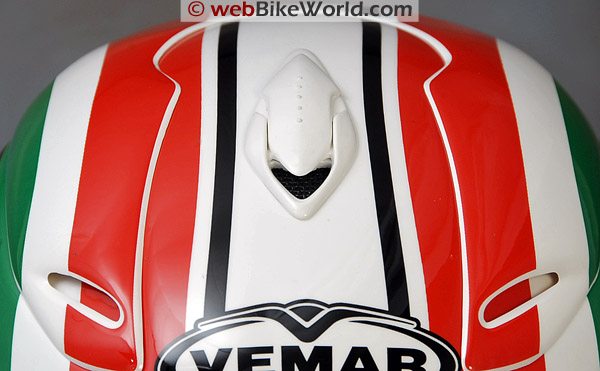
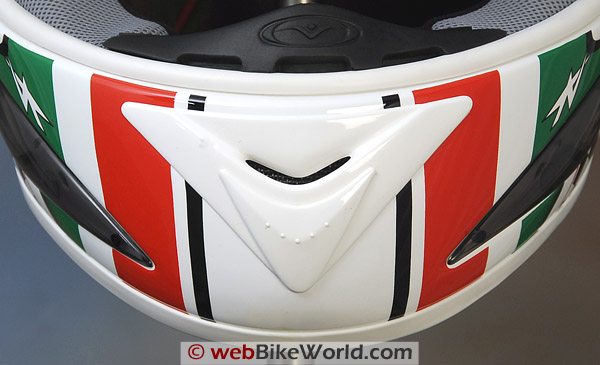
Venting
The VSREV uses the same chin vent and top vent system that Vemar used on the VSR we reviewedseveral years ago; I guess they figured they may as well stay with the familiar.
Both vents work well; each vent slider has a row of plastic nubs molded in to help provide good grip.
The vents work the way we think they should — that is, slide the top vent cover back to open it and forward to close, and slide the chin vent down to open and up to close. Somehow, this seems logical.
The top vent flows an average amount of air, although it would probably flow more air if the vent opening was oriented more towards the front of the helmet.
As it is, the air only has a clear pathway when the rider’s head is tilted forwards, although this may be just the thing for a racer or Sportbike rider.
The chin vent also offers a slightly tortuous path for the air to flow in if the rider is sitting up straight, but it also works better when the head is tilted forward.
There are two vent holes through the padding in back of the chin bar, which were blocked by some flashing left over from the padding mold.
So we trimmed them with an X-Acto knife and they now work as expected, allowing the air to flow on to the rider’s face.
The VSREV also features a chin curtain underneath the chin bar.
The exhaust vents can be opened or closed by pulling on the two tabs at the rear of the extractor, and there are two pair of always-open exhaust vents on either side of the chin bar and towards the back of the helmet.
Score: I’ll give the VSREV a “Very Good” rating for venting and air flow, which I think overall is better than average.
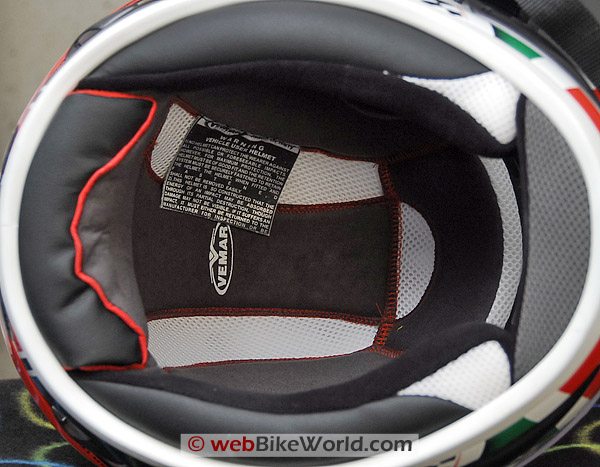
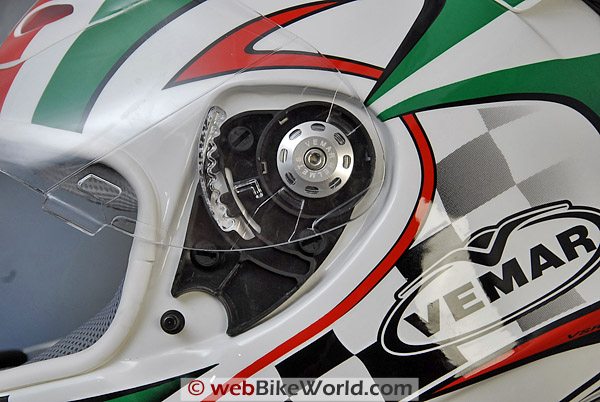
Helmet Liner
As I mentioned above, Vemar is offering a variety of cheek pad and liner sizes to custom-tailor the fit of the VSREV.
Remember that purchasing replacement cheek pad sizes is counterintuitive; that is, the cheek pads are usually labeled “S, M, L, XL”. If you want a tighter fit, you’d think that larger would be thicker, but it isn’t always so.
You have to look at this from a perspective of what size you want to change the helmet to.
The first thing to do is to confirm the size of the cheek pads that are installed in the helmet (the labels are usually on the back of the cheek pad, so you’ll have to remove them first).
If your helmet has a size L cheek pad and you want to make the helmet fit tighter, you’d go to a size M cheek pad, not a size X.
That effectively brings the helmet fit around the cheek pads down a size to what you’d expect in a medium.
Conversely, if a size large helmet has L cheek pads that feel too tight, then moving up to size XL cheek pads should loosen things up a bit, because, in effect, you’re now making the helmet fit like a size XL with the thinner cheek pads.
Note that Arai cheek pads are usually sold by their thickness in millimeters.
Anyway, the VSREV has a comfortable liner, although I wish the padding was slightly thicker; the padding feels thin on the sides, and I think it would fit me better if the helmet was a bit thicker in this area.
So I’m planning on trying a set of M cheek pads, which I think will give me just the touch of added thickness on the sides that will make for a near-perfect fit.
The material feels very soft, like a type of “ultra plush” micro-suede.
Vemar says the material is washable and “manufactured from a technical fiber that provides life-long treatment against odor, fungus and bacteria” and that it has “extraordinary wicking capabilities that result in enhanced rider comfort.”
The rear of the liner has the same type of separate section used in the Jiano, but the fit seems tighter.
The gap between this section and the sides of the liner do seem to allow more noise in than expected, so this is an area that I’d suggest could be improved.
Admittedly, this is a problem with the majority of motorcycle helmets we’ve tried.
The manufacturers haven’t yet focused on the “neck roll”; the padding around the bottom of the helmet, which is crucial to controlling helmet noise.
But overall, the soft fabric and generous fit of the VSREV makes for a comfortable fit, and the fabric does seem to control moisture better than most.
Score: I’ll give the VSREV a “Very Good” for comfort, padding and its moisture wicking ability.
Noise Levels
The Vemar VSREV seems about average with regard to its ability to control noise.
The combination of the top vents and the two small intakes for the exhaust extractor assembly, which point towards the front of the helmet, can cause some wind rushing or a slight whistling noise, but it’s about the same as expected on helmets of this type.
The fit around the neck roll or lower portion of the helmet could be tighter, as I mentioned earlier, and some low-frequency “booming” wind noises can occur in this area when riding behind a short windscreen.
We had mixed opinions after several riders wore the helmet in various conditions and on different motorcycle configurations.
So the only thing I can say in general is that while the VSREV isn’t the quietest helmet we’ve worn, it’s probably right around average for motorcycle helmet noise, if that means anything.
Be sure to visit to the wBW Motorcycle Helmet Noise page for more information. Also, note that we always wear high-quality, correctly fitted ear plugs when riding.
Please see the wBW Earplugs and Hearing Protection page for more information on choosing and wearing earplugs.
If you don’t wear ear plugs, all bets are off — every motorcycle helmet is dangerously noisy, in our opinion, and your hearing is as precious as your eyesight, so don’t mess with it. Wear ear plugs.
Score: The Vemar VSREV gets a “Good” for about average to slightly higher than normal noise levels.
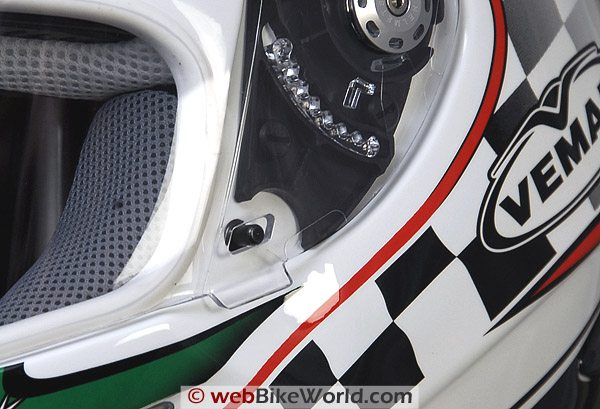
Face Shield
We think the VSREV has a larger vertical eye port opening than average, and the horizontal or side-to-side visibility is also very good — I can just see the sides of the eye port in my peripheral vision.
This allows the VSREV to work very well on a Sportbike in a leaned-forward position; better than most full-face helmets, and the excellent field of view is probably indicative of its racing heritage.
We measured the thickness of the face shield at 2.45 mm, which is slightly thicker than the 2.2 mm claimed by Vemar.
The face shield is mounted using machined aluminum side plates or disks, which have a 4 mm Allen screw in the center that must be removed to change the face shield.
The face shield was very loose when the helmet arrived and I tightened up the screws to create more friction.
The face shield detents are rather weak, but they do the job by holding the face shield in one of 5 positions when opened. The face shield can be opened slightly for demisting or ventilation.
The face shield does have more flex than we’d like, and I think the attachments on the side allow more flexibility than normal because there’s not a lot of surface bearing area between the face shield and the helmet shell.
So there’s nothing to really prevent the face shield from flexing. In other words, it’s not really the fault of the 2.45 mm face shield, but the design of the rotating mechanism and assembly.
We think the VSREV’s face shield would benefit from a centrally located face shield grasp tab, because this might help mitigate the flexing issue.
As you can see in the photo above, the face shield also has a type of lock on the left-hand side, just above the lifting tab.
It closes over an aluminum post attached to the shell, just outside the eye port on the left-hand side, under the face shield rotating mechanism.
The idea is that the hole in the face shield will snap over the post and the post will keep the face shield secure at high speeds and prevent it from opening during an over-the-shoulder head check.
This is all well and good, but it makes it difficult to open and close the face shield during normal street use.
Due to the location of the lifting tab way over on the left-hand side, there’s not much leverage and if the face shield locking system is engaged, it takes a significant amount of pressure to pop the face shield up and over the post.
It’s something you get used to I guess, and works best if I wedge my thumb underneath the tab and quickly pull forward, popping the face shield up and over the post.
On the other hand, when this face shield is locked, it’s pretty much going to stay there, which is a plus for racers or high-speed runners.
I usually end up letting the face shield just rest against the post without locking it all the way down, which means that I lose the advantage of the design and the face shield could (although it hasn’t yet) pop open during a head check at high speed.
There are other ways of locking down a face shield that are probably more elegant.
One thing several riders have noticed is that the face shield doesn’t do a very good job of preventing fog. Even in recent 75-degree (F) weather, the face shield would fog when humidity levels increased.
So this may be a good candidate for the Salclear TT anti-fog treatment we reviewed recently.
The VSREV box did contain the “extra anti-fog, non-scratch 2.2 mm thick quick release dark tinted shield” that Vemar says is included with each helmet; the Jiano box did not have the extra tinted face shield.
Score: I’ll give the VSREV an “Excellent” for the field of view offered by the wide eye port and a “Good” for operation and overall impressions of the face shield.
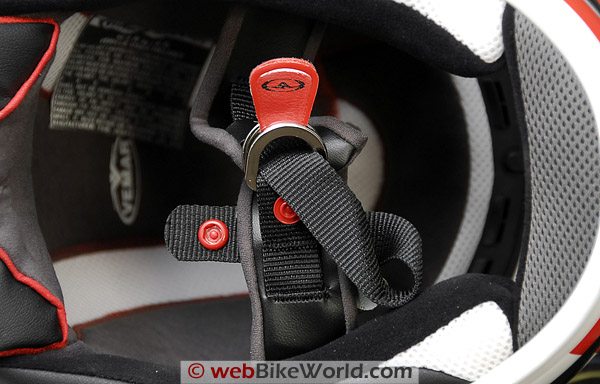
Helmet Weight
Vemar claims that the carbon fiber version of the VSREV weighs 1310 grams in size medium, while the “regular” VSREV in the same size is claimed weigh 1470 grams.
1310 grams isn’t really very light, especially for a carbon fiber helmet (and especially for a size medium).
So that’s a clue that the VSREV uses either a fairly thick shell or fittings or something about it is a bit more, shall we say “robust” than other helmets.
The VSREV shown here in size large weighs 1748 grams (3 lbs., 13-5/8 oz.).
This is consistent with the sticker on the back of the helmet, which says that it weighs 1690 grams, plus or minus 50 grams.
This is relatively heavy for a size large helmet, and it puts the VSREV in the 70-80 range of the 93 helmets we’ve reviewed to date.
This is the same neighborhood as the Scorpion EXO-700 (review) in size XL at 1733 grams and theJoe Rocket RKT 101 (review), also in size XL, at 1737 grams.
See the wBW Motorcycle Helmet Weights page for more information.
The VSREV feels very slightly top heavy on my round head, only because the oval shape at the upper inside portion of the helmet is a slight mis-match for my head shape.
Others who have worn the helmet have reported that it feels nicely balanced.
The helmet feels solid on riders who fit the shape, and it doesn’t seem to exhibit any undue movement or lift, so the aerodynamics work.
Score: The VSREV gets a “Poor” for its weight and a “Very Good” for balance.
Miscellaneous
The VSREV has the classic D-ring chin strap adjuster, along with a snap to hold the excess. Vemar even makes different sized chin straps that are available for purchase for a more custom fit.
The padding under the chin strap uses the same cushy lining material as the rest of the liner, which makes it feel comfortable.
And the evaluators who wore the helmet all said they could fit their normal eyeglasses over their ears when wearing the VSREV, probably due to the wider internal shape.
The VSREV meets DOT safety standards in the U.S. and it is also labeled with an ECE 22.05 sticker on the back.
Our understanding is that the ECE doesn’t like this sticker to be used outside of member countries, but it’s there nonetheless.
The helmet has a 5-year warranty, which is commendable.
| webBikeWorld Opinionator: Vemar VRX7 | |
|---|---|
| Picks… | …and Pans |
|
|
Conclusion
The “Italy” graphics go a long way towards making this VSREV a real keeper.
But artwork aside, the overall shape of the helmet and the large eye port, along with the unique internal shape and fit, make a very nice package.
The quality of the helmet is high and the fact that it’s all made in Italy and assembled by hand is a plus.
Motorcyclists who have been searching for this particular fit will probably rejoice.
| wBW Review: Vemar VSREV Helmet | |
|---|---|
| Manufacturer: Vemar Helmets (Italy) | List Price: $475.00 |
| Colors: Solids and graphics. | Made In: Italy |
| Sizes: XS-XL Shell Sizes: Unknown | Review Date: June 2008 |
|
Rating Scale is subjective: Unacceptable, Poor, Neutral, Very Good, Excellent, Outstanding.
|
|
Note: Item provided by a retailer, distributor or manufacturer with these Terms and Conditions.
Owner Comments and Feedback
See details on submitting comments.
From “T.S.” (10/09): “I purchased this helmet after reading and watching your review. I’d like to make the following observations after about 900 miles wearing this helmet.
This is not scientific and certainly not as complete as your review, but I’m an average rider who encounters everyday experiences on the bike.
I committed the cardinal sin of not trying on this helmet before buying.
I live in an area where motorcycle accessory stores are limited. I usually do not find anything that is not Arai, Shoei, or HJC. I took the plunge and I purchased one on-line from RevZilla.com.
They had a really great price and the size I needed. I figured on a large because I wear a large in Shoei and AGV. This was a good choice, though I did note in your review that this model may run a little large.
I fretted over my choice, but in the end, I am happy with it.
As you noted, it runs rounder than I am used to, but I wear glasses when I ride and the little extra space helps a lot. Despite the roundness, this helmet fits well at the top of my head and along the cheeks and jaw.
I was hoping that the helmet would be light, since it’s made of carbon fiber.
Unfortunately, it is not lighter than my AGV V-Flyer. It is only about three ounces heavier, but it is not as light as I expected.
The graphics are really very nice. The top coat looks like it will protect what’s underneath. The finish is typically Italian. Not perfect, but certainly well done. This is my first graphic helmet, so I was not sure what to expect.
Of course, while riding, I have no idea what’s on top of my head, so the experience is no different, but concerning finish, paint overlap, edge matching, etc., the finish looks very nice.
When it comes to venting, my Shoei RF-900 was terrible. My AGV vents very well. I wanted to compare the Vemar against these two standards.
I would say it vents on par with the AGV. There is a metal mesh inside the intake vents. Nice touch: Keeps the bigger bugs out.
The inner liner is channeled so the air flows well around the head. The face shield doesn’t fog easily. Again, a shortcoming with the Shoei. It would fog up on a hot, dry summer day, seemingly before I’d put it on!
On a cold, humid morning (and we have a lot of those here in Western Washington), there is little to no fogging. I think my glasses fog up rather than the shield.
Speaking of the shield, this is the first time I have had a shield that requires a tool. I thought that would be a negative, but frankly, I don’t change shields on the fly. The tool required is a 3 mm hex, which I have handy in my toolbox.
The shield is clear and easy to see through, with no visible distortion in the main viewing area. The opening is large and the shield itself is thick and not at all flimsy.
The locking mechanism on the side is interesting, but frankly, I don’t ride fast enough to need it. One really nice touch is the inclusion of a light smoke shield. I have never had a helmet with an additional shield thrown in for free.
I like it. It’s not a very dark shield, but it provides enough extra protection on a sunny day to cut the glare.
Although not advisable for night riding, if you get caught out in the early evening, it’s still clear enough to get yourself home safely.
The shape of the Vemar is very round. The shell is larger side to side than my AGV. The back lower edge is cut higher than I am used to.
At first glance, I wondered what effect that would have. As it turns out, it means I have better visibility while riding. I ride an Aprilia RSV 1000 which has a fairly low riding position.
Usually, when I lift my head, I can feel the back of the helmet on my neck or against my backpack if I’m riding to work.
With the Vemar, there is a lot of extra clearance in the back and I can lift my head comfortably without feeling the helmet cut into my neck. This is really a nice feature.
It means, though, that a lot more air gets in around the neck. As has been pointed out many times, the more air that gets in under the helmet, the louder it tends to be. This helmet is not quiet.
I always wear earplugs when riding, and so should everyone else, so it doesn’t bother me. I can tell it lets in more sound, but the earplugs make it seem about the same as my other helmets have been.
I am not sure if more rain will get in, though, through that same opening.
I ride in all weather except snow (though I have even been caught unawares in two different snowstorms: not a good experience!), and so far, in light rain, I have had any problems. We will have to wait until the heavy rains begin.
Overall, I am very pleased with this helmet. I got a good deal on what is a well made lid. I would recommend it for those who are not afraid to buy something that is not mainstream.
I would recommend trying one on first and taking a ride with it. I did not have that luxury, but I think it’s always a good idea, if you can do it. I have no complaints so far and look forward to many miles of riding with this helmet.”


